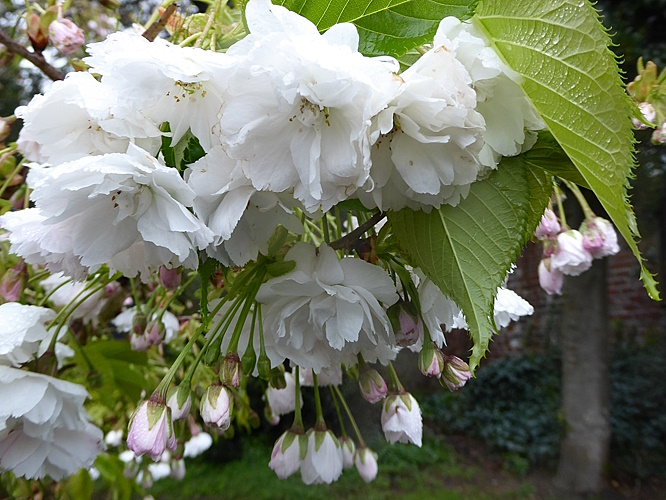
It was grey and damp as I set out, and it settled into a persistently dismal drizzle all day. Our plan was to walk across the fields from Hoylake to Gilroy Nature Park, near West Kirby. Along New Hall Lane there were plenty of wayside “weeds” doing well at the edge of the pavement – Shepherd’s Purse, Green Alkanet, Goose Grass, Mallow, Scarlet Pimpernel, many of them not in flower yet, but there was a gorgeous crimson Crab Apple tree blooming near the entrance to New Hall Farm.

We passed Whitegate Animal Sanctuary and stopped to gawk at the pigs and poultry. Then along the path between the fields, the route we had attempted on 18 December last year, but had been defeated by the ice.

A Wren dived out of sight into a ditch as we approached and seven or eight Shelduck flew over in a tight flock, heading south. All the Dandelion flowers were closed up tight in the cold rain, but there were large patches of Red Dead-nettle, the Elder flower buds were well formed, and the earliest flowers of Garlic Mustard were just showing.

It had been cold and bleak between the open fields, but as we approached Gilroy we were at last sheltered by overhanging trees and the path was lined with the coastal plant known as Alexanders.


A huge carpet of Lesser Celandine stretched right back into the woods.

Inside the Nature Park bluebells were coming out under the trees. A Chiffchaff called, and there were a few Mallards out on Gilroy Pool, but then we spotted a fast-moving bird – a Swallow over the water. But the rain was dripping down our necks, so we knew that one Swallow definitely doesn’t make a summer! (It was too fast to be in this picture, in case you are squinting.)

Around the edges of the pool were clumps of a grass-like tussocky plant, with black flower buds opening to yellow. It appears to be Black Bog-Rush Schoenus nigricans, a native plant. It is said to be common in Scotland and East Anglia, but the NBN Atlas doesn’t show any records of it between Formby and North Wales. The Freshwater Habitats Trust says “Black Bog-rush is not a rush but a sedge! This beautiful species can be recognised for its almost 1m in height and its dense tufts with dark fruiting heads. Black Bog-rush flowers from April to June, and it is the host plant for various moths and flies, and food for mammals such as rabbits.”

The last section of the path to West Kirby runs next to some allotments, and is bordered by an avenue of newly-planted Apple trees of many varieties, some with legible labels. We could read the ones for Egremont Russet and Laxton Fortune. They were all starting to blossom.

A sign for “Incredible Edibles” says “When it’s ripe, feel free to pick some fruit” and adds “This apple avenue is an invitation to consider where our food comes from”.

By then it was nearly noon, but with no shelter in sight we got the bus a few stops into West Kirby, dropped into Morrison’s for the loos, then had a late lunch in the shelters in the ornamental gardens at the corner of Victoria Drive. It was still raining, and we were getting cold and bedraggled, so it was time to go home. We had time to look into Sandlea Park on the way to the station. It’s only a tiny park, but pretty. There were more Bluebells coming out, a mix of blue and white, and they looked lovely, especially against some old beech leaves.

A pink tree was just coming into leaf, probably an otherwise-ordinary Sycamore, but of the variety ‘Brilliantissimum’, in which the green chlorophyll is late to develop.

Finally, a lovely white Cherry with its characteristic hanging blossom.

Public transport details: Train from Central towards West Kirby at 10.05, arriving Hoylake 10.30. Returned on the train from West Kirby at 2.30, arriving Liverpool at 3.10.
